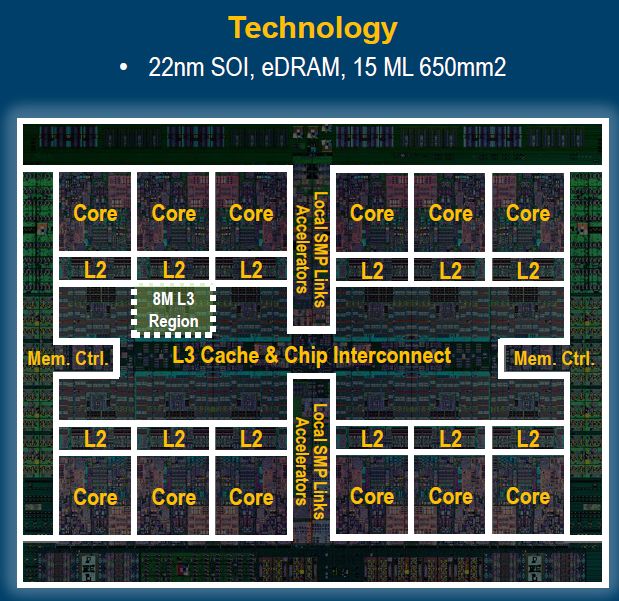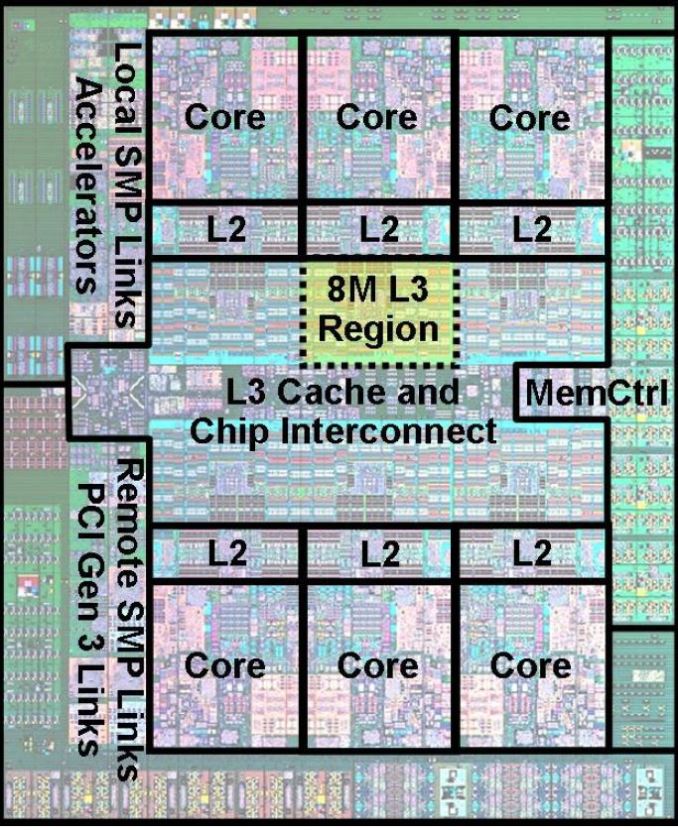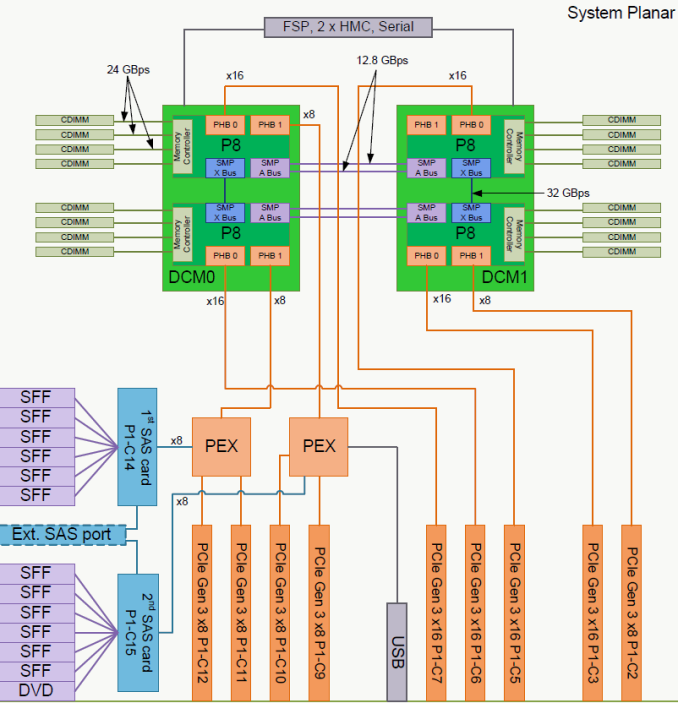The IBM POWER8 Review: Challenging the Intel Xeon
by Johan De Gelas on November 6, 2015 8:00 AM EST- Posted in
- IT Computing
- CPUs
- Enterprise
- Enterprise CPUs
- IBM
- POWER
- POWER8
Inside the S822L: Hardware Components
The 2U Rack-mount S822L server contains two IBM POWER8 DCM sockets. Each socket thus contains two cores connected by a 32GBps interconnect. The reason for using a Multi-Chip-Module (MCM) is pretty simple. Smaller five-to-six core dies are a lot cheaper to produce than the massive 650 mm² monolithic 12-core dies. As a result the latter are reserved for IBM's high-end (E880 and a like). So while most POWER8 presentations and news posts on the net talk about the multi-core die below...
... it is actually an MCM with two six core dies like the one below that is challenging the 10 to 18 core Xeons. The massive monolithic 10-12 core dies are in fact reserved for much more expensive IBM servers.
The layout of the S822L is well illustrated by the scheme inside the manual.
Each DCM offers 48 PCIe Gen 3 lanes. 32 of those lanes are directly connected to the processor while 16 connect to PCIe switches. The PCIe switches have "only" 8 lanes upstream to the DCM, but offer 24 lanes to "medium" speed devices downstream. As it unlikely that both your SAS controllers and your network controllers will gobble up the full PCIe x8 bandwidth, this is a very elegant way to offer additional PCIe lanes.













146 Comments
View All Comments
hissatsu - Friday, November 6, 2015 - link
You might want to look more closely. Thought it's a bit blurry, I'm almost certain that's the 80+ Platinum logo, which has no color.DanNeely - Friday, November 6, 2015 - link
That's possible; it looks like there's something at the bottom of the logo. Google image search shows 80+ platinum as a lighter silver/gray than 80+ silver; white is only the original standard.Shezal - Friday, November 6, 2015 - link
Just look up the part number. It's a Platinum :)The12pAc - Thursday, November 19, 2015 - link
I have a S814, it's Platinum.johnnycanadian - Friday, November 6, 2015 - link
Oh yum! THIS is what I still love about AT: non-mainstream previews / reviews. REALLY looking forward to more like this. I only wish SGI still built workstation-level machines. :-(mapesdhs - Tuesday, November 10, 2015 - link
Indeed, but it'd need a hefty change in direction at SGI to get back into workstations again, so very unlikely for the forseeable future. They certainly have the required base tech (NUMALink6, MPI offload, etc.), namely lots of sockets/cores/RAM coupled with GPUs for really heavy tasks (big data, GIS, medical, etc.), ie. a theoretical scalable, shared-memory workstation. But the market isn't interested in advanced performance solutions like this atm, and the margin on standard 2/4-socket systems isn't worthwhile, it'd be much cheaper to buy a generic Dell or HP (plus, it's only above this no. of sockets that their own unique tech comes into play). Pity, as the equivalent of a UV 30/300 workstation would be sweet (if expensive), though for virtually all of the tasks discussed in this article, shared memory tech isn't relevant anyway. The notion of connectable, scalable, shared memory workstations based on NV gfx, PCIe and newer multi-core MIPS CPUs was apparently brought up at SGI way back before the Rackable merger, but didn't go anywhere (not viable given the financial situation at the time). It's a neat concept, eg. imagine being able to connect two or more separate ordinary 2/4-socket XEON workstations together (each fitted with, say, a couple of M6000s) to form a single combined system with one OS instance and resources pool, allowing users to combine & split setups as required to match workloads, but it's a notion whose time has not yet come.
Of course, what's missing entirely is the notion of advanced but costly custom gfx, but again there's no market for that atm either, at least not publicly. Maybe behind the scenes NV makes custom stuff the way SGI used to for relevant customers (DoD, Lockheed, etc.), but SGI's products always had some kind of commercially available equivalent from which the custom builds were derived (IRx gfx), whereas atm there's no such thing as a Quadro with 30000 cores and 100GB RAM that costs $50K and slides into more than one PCIe slot which anyone can buy if they have the moolah. :D
Most of all though, even if the demand existed and the tech could be built, it'd never work unless SGI stopped using its pricing-is-secret reseller sales model. They should have adopted a direct sales setup long ago, order on the site, pricing configurator, etc., but that never happened, even though the lack of such an option killed a lot of sales. Less of an issue with the sort of products they sell atm, but a better sales model would be essential if they were to ever try to sell workstations again, and that'd need a huge PR/sales management clearout to be viable.
Pity IBM couldn't pay NV to make custom gfx, that'd be interesting, but then IBM quit the workstation market aswell.
Ian.
mostlyharmless - Friday, November 6, 2015 - link
"There is definitely a market for such hugely expensive and robust server systems as high end RISC machines are good for about 50.000 servers. "Rounding error?
DanNeely - Friday, November 6, 2015 - link
50k clients would be my guess.FunBunny2 - Friday, November 6, 2015 - link
(dot) versus (comma) most likely. Euro centric versus 'Murcan centric.DanNeely - Friday, November 6, 2015 - link
If that was the case, a plain 50 would be much more appropriate.